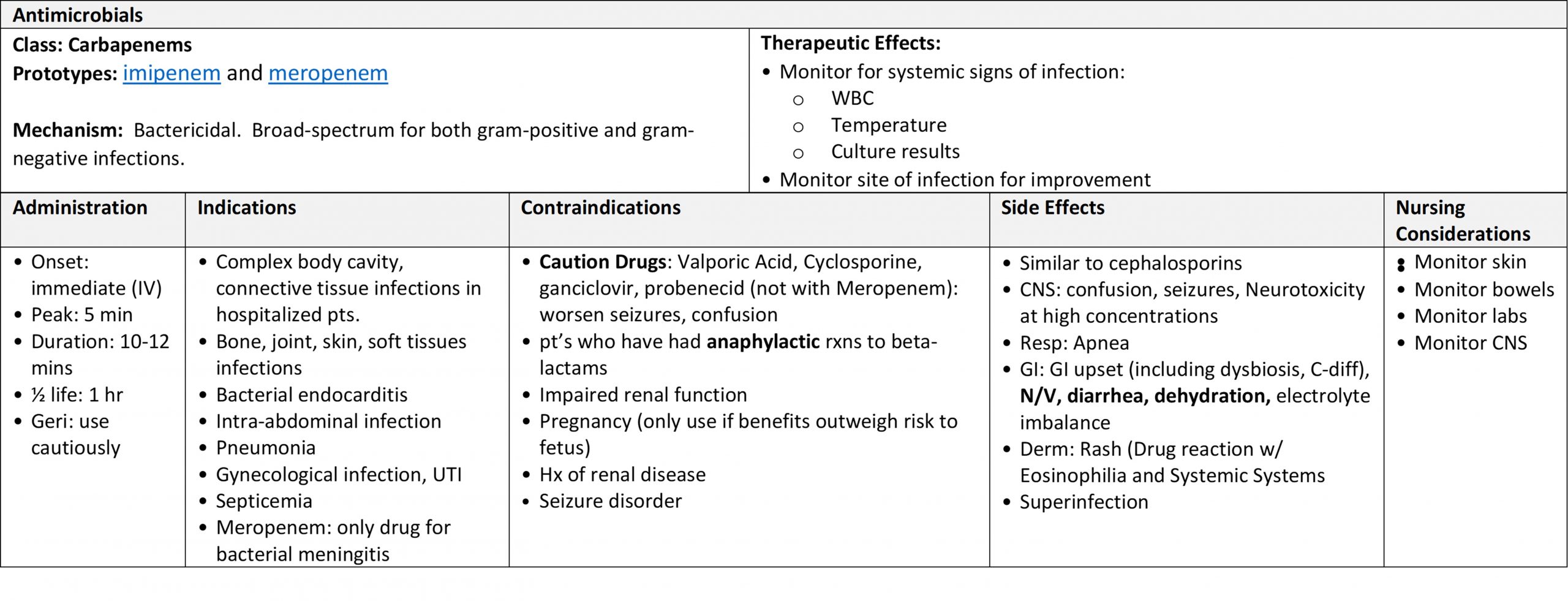Antimicrobials
3.8 Carbapenems
Open Resources for Nursing (Open RN)
Carbapenems are a beta-lactam “cousin” to penicillins and cephalosporins.
Indications for Use: Carbapenems are useful for treating life-threatening, multidrug-resistant infections due to their broad spectrum of activity.[1] These antibiotics are effective in treating gram-positive and gram-negative infections. Because of their broad spectrum of activity, these medications can be especially useful for treating complex hospital-acquired infections or for clients who are immunocompromised.
Mechanism of Action: Carbapenems are typically bactericidal and work by inhibiting the synthesis of the bacterial cell wall.
Nursing Considerations Across the Lifespan: Some carbapenems (eg. meropenem) are considered safe for use in pediatrics. Dose adjustments are required based on renal dysfunction in older adults. Information related to carbapenems in pregnancy is limited.
Specific Administration Considerations: Carbapenems are similar to cephalosporins. Cross sensitivity may occur in clients allergic to pencillin or cephalosporins.
Client Teaching & Education: Clients should monitor for signs of superinfection and report any occurrence to the provider. If a client experiences fever and bloody diarrhoea, they should contact the provider immediately. The client should also be advised that side effects can occur even weeks after the medication is discontinued.[2]
Now let’s take a closer look at the medication card for Carbapenems in Table 3.7.[3][4] Because information about medication is constantly changing, nurses should always consult evidence-based resources to review current recommendations before administering specific medication.
Table 3.7 Carbapenem Medication Card
Class: Carbapenems (prototypes: imipenem and meropenem)

Clinical Reasoning and Decision-Making Activity 3.7a
Using the above information, consider the following clinical scenario question:
John Smith was admitted to the hospital with a serious abdominal infection. The nurse notices that this client is allergic to penicillin as he prepares to administer the first dose of imipenem medication. What is the nurse’s next best action?
Note: Answers to the activities can be found in the “Answer Key” sections at the end of the book.
Media Attributions
- carbapenems
- Papp-Wallace, K. M., Endimiani, A., Taracila, M. A., & Bonomo, R. A. (2011). Carbapenems: past, present, and future. Antimicrobial agents and chemotherapy, 55(11), 4943–4960. https://www.ncbi.nlm.nih.gov/pmc/articles/PMC3195018/ ↵
- uCentral from Unbound Medicine. https://www.unboundmedicine.com/ucentral ↵
- Daily Med, https://dailymed.nlm.nih.gov/dailymed/index.cfm, used for hyperlinked medications in this module. Retrieved June 27, 2019. ↵
- UpToDate (2021). Meropenem. https://www.uptodate.com/contents/search ↵

